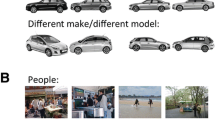Abstract.
Brain imaging studies suggest that expert object recognition is a distinct visual skill, implemented by a dedicated anatomical pathway. Like all visual pathways, the expert recognition pathway begins with the early visual system (retina, LGN/SC, striate cortex). It is defined, however, by subsequent diffuse activation in the lateral occipital complex (LOC) and sharp foci of activation in the fusiform gyrus and right inferior frontal gyrus. This pathway recognizes familiar objects from familiar viewpoints under familiar illumination. Significantly, it identifies objects at both the categorical and instance (a.k.a. subcategorical) levels, and these processes cannot be disassociated. This paper presents a four-stage functional model of the expert object recognition pathway, where each stage models one area of anatomic activation. It implements this model in an end-to-end computer vision system and tests it on real images to provide feedback for the cognitive science and computer vision communities.
Similar content being viewed by others
References
Biederman I (1987) Recognition-by-components: a theory of human image understanding. Psychol Rev 94(2):115-147
Bruce V, Young A (1998) In the eye of the beholder: the science of face perception. Oxford University Press, New York, p 280
Bülthoff HH, Edelman S (1992) Psychophysical support for a 2-D view interpolation theory of object recognition. Proc Natl Acad Sci USA 89:60-64
Bülthoff HH, Wallraven C, Graf A (2002) View-based dynamic object recognition based on human perception. In: Proceedings of the international conference on pattern recognition, Quebec City
Chao LL, Martin A, Haxby JV (1999) Are face-responsive regions selective only for faces? NeuroReport 10(14): 2945-2950
Clark VP(1996) Functional magnetic resonance imaging of human visual cortex during face matching: a comparison with positron emission tomography. NeuroImage 4:1-15
Draper BA, Lionelle A (2003) Evaluation of selective attention under similarity transforms. In: Proceedings of the workshop on performance and attention in computer vision, Graz, Austria
Frey BJ, Colmenarez A, Huang TS (1998) Mixtures of local linear subspaces for face recognition. In: Proceedings of the IEEE conference on computer vision and pattern recognition. IEEE Press, Santa Barbara, CA
Gauthier I, Logothetis NK (2000) Is face recognition not so unique after all? Cogn Neuropsychol 17(1/2/3):125-142
Gauthier I(1997) Behavioral and neural changes following expertise training. In: Proceedings of the annual meeting of the Psychonomic Society, Philadelphia
Haxby JV(1999) The effect of face inversion on activity in human neural systems for face and object recognition. Neuron 22:189-199
Ishai A(1999) Distributed representation of objects in the human ventral visual pathway. Science 96:9379-9384
Itti L, Koch C, Neibur E (1998) A model of saliency-based visual attention for rapid scene analysis. IEEE Trans Patt Anal Mach Intell 20(11):1254-1259
Kambhatla N, Leen TK (1997) Dimension reduction by local PCA. Neural Comput 9:1493-1516
Kanwisher N(1996) Functional imaging of human visual recognition. Cogn Brain Res 5:55-67
Kosslyn SM (1994) Image and brain: the resolution of the imagery debate. MIT Press, Cambridge, MA, p 516
Kosslyn SM(1999) The role of area 17 in visual imagery: convergent evidence from PET and rTMS. Science 284:167-170
Kourtzi Z, Kanwisher N (2000) Cortical regions involved in perceiving object shape. J Neurosci 20(9):3310-3318
Lee TS(1998) The role of the primary visual cortex in higher level vision. Vision Res 38:2429-2454
Lowe DG (1985) Perceptual organization and visual recognition. Kluwer, Boston
Maguire E, Frith CD, Cipolotti L (2001) Distinct neural systems for the encoding and recognition of topography and faces. NeuroImage 13(4):743-750
Maki A, Nordlund P, Eklundh J-O (2000) Attentional scene segmentation: integrating depth and motion from phase. Comput Vision Image Understand 78(3):351-373
Marr D (1982) Vision. Freeman, Cambridge, MA
Nakamura K(2000) Functional delineation of the human occipito-temporal areas related to face and scene processing: a PET study. Brain 123:1903-1912
Oliva A, Schyns PG (1997) Coarse blobs or fine edges? Evidence that information diagnoticity changes the perception of complex visual stimuli. Cogn Psychol 34:72-107
O’Toole AJ(1994) Structural aspects of face recognition and the other race effect. Mem Cogn 22:208-224
Palmer SE (1999) Vision science: photons to phenomenology. MIT Press, Cambridge, MA, p 810
Park S-J, Shin J-K, Lee M (2002) Biologically inspired saliency map model for bottom-up visual attention. In: Proceedings of the international workshop on biologically motivated computer vision. Springer, Berlin Heidelberg New York
Parkhurst D, Law K, Neibur E (2002) Modeling the role of salience in the allocation of overt visual attention. Vision Res 42(1):107-123
Pollen DA, Gaska JP, Jacobson LD (1989) Physiological constraints on models of visual cortical function. In: Rodney M, Cotterill J (eds) Models of brain functions. Cambridge University Press, New York, pp 115-135
Puce A(1995) Face-sensitive regions in human extrastriate cortex studied by functional MRI. J Neurophysiol 74:1192-1199
Tanaka JW, Curran T (2001) A neural basis for expert object recognition. Psychol Sci 12(1):43-47
Tarr MJ, Gauthier I (2000) FFA: a flexible fusiform area for subordinate-level visual processing automatized by expertise. Neuroscience 3(8):764-769
Tipping ME, Bishop CM (1999) Mixtures of probabilistic principal component analysers. Neural Comput 11(2):443-482
Tong F(2000) Response properties of the human fusiform face area. Cogn Neuropsychol 17(1/2/3):257-279
Tsotsos JK(1995) Modeling visual attention via selective tuning. Artif Intell 78(1-2):507-545
Ungeleider LG, Mishkin M (1982) Two cortical visual systems. In: Ingle DJ, Goodale MA, Mansfield RJW (eds) Analysis of visual behavior. MIT Press, Cambridge, MA, pp 549-586
Zipser K, Lamme VAF, Schiller PH (1996) Contextual modulation in primary visual cortex. Neuroscience 16(22):7376-7389
Author information
Authors and Affiliations
Corresponding author
Additional information
Published online: 4 November 2004
Correspondence to: Bruce A. Draper
Kyungim Baek: Current address: Department of Biomedical Engineering, Columbia University, New York, NY, USA
Rights and permissions
About this article
Cite this article
Draper, B.A., Baek, K. & Boody, J. Implementing the expert object recognition pathway. Machine Vision and Applications 16, 27–32 (2004). https://doi.org/10.1007/s00138-004-0147-4
Issue Date:
DOI: https://doi.org/10.1007/s00138-004-0147-4




